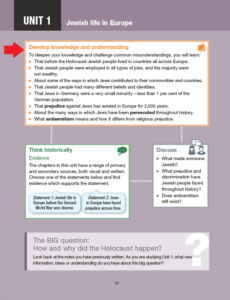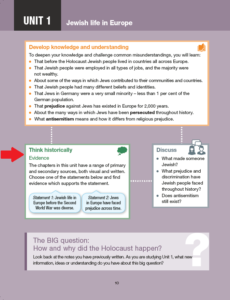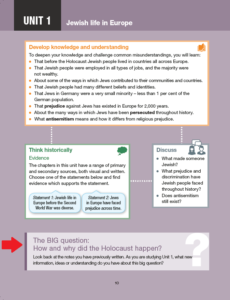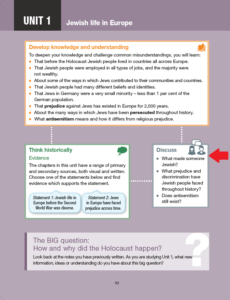Glossary
Allied powers: The countries that fought against Germany. These include Britain, France (except the period of Nazi occupation 1940–44), the Soviet Union from June 1941 and the USA from December 1941, but there were many other ‘Allied’ nations.
Allies: Countries which formally cooperate with each other for a military or other purpose.
Anschluss: A German word for ‘union’. The word refers to the joining of Austria with Nazi Germany in March 1938.
Antisemitism: Hostility to or prejudice against Jews.
Assimilated: When someone becomes part of the wider society and culture.
Axis powers: Those countries which fought with Germany. These include Italy, Japan, Hungary, Romania, Bulgaria and other countries.
British Mandate of Palestine: After the defeat of the Ottoman Empire in the First World War, the League of Nations placed the Middle Eastern territory known as ‘Palestine’ under British control. It was referred to as the British Mandate of Palestine. The British ruled the area from 1920 until 1948.
Castrated: When an individual loses use of the testicles, either by surgical or chemical action. Causes the individual to become sterile (unable to have children).
Collaborators: People, organisations and governments that helped the Nazis persecute and/or murder Jews.
Communist: A person who supports and believes in the principles of communism. Communism is a political ideology about how societies and economies should be organised. It argues, for instance, that resources and industries be collectively owned for the benefit of everyone.
Compensation: Something, usually money, given to someone in recognition of loss, suffering, or injury.
Concentration camps: Places where large numbers of people were kept as prisoners under armed guard.
Curfew: A rule requiring people to leave the streets or be at home at a certain time.
Death camp: Killing centres established by the Nazis in Central Europe during the Second World War. There were six sites: Chelmno, Belzec, Sobibor, Treblinka, Majdanek, and Auschwitz-Birkenau. Approximately 2.5 million European Jews were murdered at these places primarily by gassing in specially built chambers or gas vans. Roma and Sinti and other victims were also murdered in the death camps.
Demonised: Something or someone portrayed as wicked and threatening.
Deportation: Forcibly removing someone from one country to another.
Dictator: A person who rules with total authority.
Discrimination: Unfairly treating an individual or a group differently from others.
Einsatzgruppen: special units of the Security Police and SD. With the help of the SS, police units, the army and local collaborators, the Einsatzgruppen conducted mass shootings in the Soviet Union, targeting Jews, Roma, communists and Soviet civilians.
Emigrate: To leave the country you live in to move to a different country. This movement might be voluntary, or it might be forced upon someone by war, conflict, or natural disaster.
Enabling Act: An act passed by the Reichstag (the German parliament) on 23 March 1933 which gave Hitler the right to make laws without the Reichstag’s approval for the next four years. It gave Hitler and the Nazis absolute power to make laws, which enabled them to destroy all opposition.
‘Euthanasia’ programme: Euthanasia means literally ‘good death’. It usually refers to causing a painless death for a seriously ill individual who would otherwise suffer. In the Nazi era, however, the term was used for a secret murder programme. Its goal was to kill people with mental and physical disabilities who, the Nazis believed, weakened the ‘Aryan race’.
Expel: Force someone to leave a place.
Genocide: Any act committed with intent to destroy, in whole or in part, a national, ethnic, racial or religious group. In 1944, after witnessing Nazi brutality in occupied Europe, the Jewish-Polish lawyer Raphael Lemkin invented the phrase ‘genocide’. The term combined the Greek word genos (race or tribe) with the Latin word cide (to kill). On December 9 1948 the United Nations declared genocide to be an international crime.
Ghettos: Areas in towns or cities where Jews were separated by force from other people. Ghettos were overcrowded and living conditions were miserable. The first recorded ghetto was created in Venice, Italy, in 1516.
Great Depression: The worst economic downturn in the history of the industrialised world. It started in 1929 in the USA but because Germany depended on American financial support it led to the collapse of the German economy.
Interned: Being confined as a prisoner, especially for political or military reasons.
Israel: A country between Jordan and the Mediterranean Sea. Established in 1948 as a Jewish state in a region that was formerly known as the British Mandate of Palestine. Many regard the land of Israel to be the ancient homeland of the Jewish people.
Jehovah’s Witnesses: Christians who worship Jehovah, the God of the Bible. They have certain distinct beliefs. Many refused to serve in the army or accept the Nazi’s total power, believing that they were first answerable to God.
Liberation: Setting someone free.
Nazi Germany: The German state between 1933 and 1945, when Adolf Hitler and the Nazi Party controlled the country.
Neutrality agreement: An agreement between countries not to take military action against each other. In August 1939, Germany and the Soviet Union signed a neutrality agreement known as the Molotov-Ribbentrop Pact or the Nazi-Soviet Pact.
Orthodox Jews: Jews who understand their religion – Judaism – in a traditional way and live their lives according to religious laws.
Partisan: a member of an armed group formed to fight against an occupying force.
Persecution/Persecuted: Being treated badly, usually because of ‘race’ or religious or political beliefs.
Pogrom: An organised massacre of a particular group.
Police state: A state controlled by a political police force that secretly supervises people’s activities.
Political opponents: People who belong to a different party or who have different ideas and beliefs.
Prejudice: An unfair opinion, judgement or feeling towards someone.
Propaganda: Spreading information, which is often false or misleading, to persuade people to support a point of view or cause.
Rations: A fixed amount of food or other necessities (such as soap) that each person is allowed to have.
Refugees: People who have been forced out of their country and cannot return home safely.
Remilitarise: To militarise again; rearm after being disarmed. After the First
World War, the Treaty of Versailles did not allow the German army in the Rhineland. In March 1936, however, Hitler ordered German troops to enter it.
‘Resettlement’: An expression often used by the Nazis to refer to the deportation of Jews and others to sites of murder located in Eastern Europe.
Roma and Sinti: Roma and Sinti are the largest European minority and have lived in Europe for over 1,000 years. ‘Sinti’ refers to the members of an ethnic minority that settled in Germany and neighbouring countries in the early fifteenth century. ‘Roma’ refers to the ethnic minority that has lived in Eastern and South-Eastern Europe since the Middle Ages. Some Roma migrated to Western Europe in the eighteenth century. Roma and Sinti is the real name of the so called ‘Gypsies’.
Scapegoat: Someone who is blamed for the wrongdoings, mistakes or faults of others.
Shtetls: Towns or villages with a large Jewish population.
Sub camps: Concentration camps and work camps often had a network of smaller camps attached to them, known as sub camps.
Testimony: A spoken or written statement describing an event or experience.
Trade Union: An organised association of workers in a trade or profession, formed to protect and further their rights and interests.
Work camps: Camps in which prisoners were forced to work as slave labourers.
Yiddish: A form of German usually spoken by Jewish people in Eastern Europe at this time.
DOWNLOAD: Printable Glossary of Terms





